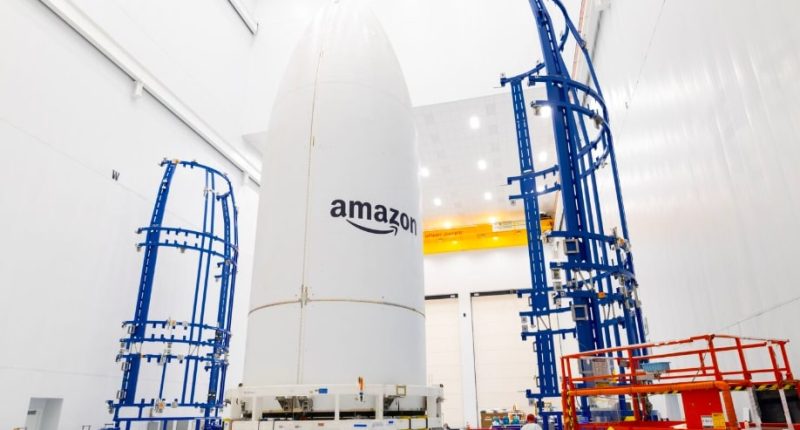Early on Wednesday, July 16, at 2:18 AM Eastern Time, SpaceX’s Falcon 9 rocket will launch 24 operational satellites for Starlink-rival, Amazon’s Project Kuiper. The mission, designated KF‑01, marks a new phase in Amazon’s satellite broadband deployment, using a partner rocket for the first time, that too from a rival in the internet satellites business. The launch will take place at Cape Canaveral’s Space Launch Complex 40, and a livestream will be available on X. Until now, Amazon has relied solely on United Launch Alliance (ULA) Atlas V rockets, launching two batches of 27 satellites each in April and June. These early missions increased Kuiper’s on-orbit total to 54. If the KF‑01 launch is successful, the constellation will rise to 78 satellites.
Choosing SpaceX (which already operates Starlink, Kuiper’s main competitor) marks a shift from Amazon’s prior “launch-agnostic” stance. Amazon has contracted three Falcon 9 flights among 83 total launches across ULA, Arianespace, Blue Origin, and SpaceX to meet the schedule locked in by the Federal Communications Commission (FCC).
Amazon must orbit at least 1,618 satellites (half of its planned 3,236-unit constellation) by July 30, 2026. That leaves fewer than 18 months to deploy nearly 1,600 satellites at current manufacturing and launch rates, which is a tight timeline. With only 78 satellites scheduled after this launch, an acceleration in pace (and perhaps schedule extensions or additional launches) will be critical.
As of late March, SpaceX has roughly 7,100 operational Starlink satellites, a figure rising past 9,000 by July, serving approximately 6 million subscribers. Comparatively, Kuiper is still nascent. Amazon aims to leverage cheaper user terminals and integration with AWS as well. Three terminal models are being designed, ranging from compact 7-inch units (100 Mbps) to enterprise-grade models delivering up to 1 Gbps. Manufacturing targets are under $400 per unit, aiming to be more cost-effective than Starlink’s $599 kits. Amazon is also pursuing partnerships (such as with Vodafone and Verizon)to integrate Kuiper into broader telecommunications infrastructure, allowing it to serve as a rural or enterprise backhaul solution.
To add some context, Amazon had formally announced Project Kuiper in April 2019, shortly after filing plans with the Federal Communications Commission to deploy a constellation of 3,236 broadband satellites in low Earth orbit. In 2020, the FCC granted approval with a condition that Amazon must launch half the constellation by mid-2026. Progress was slow in the early years. Hardware development, regulatory compliance, and facility construction extended timelines beyond internal projections. The first test satellites were eventually deployed in October 2023 aboard an Atlas V rocket.
The project has consumed over $10 billion to date. Bank of America analysts estimate total costs could reach $23 billion, with satellite production costs alone potentially hitting $1.1 billion in Q4 2025, and launch costs averaging around $150 million per mission. BofA projects annual Kuiper revenues of $7.2 billion by 2032, based on about seven million subscribers paying $80 per month, though the break‑even timeline remains uncertain.
Wall Street analysts are divided: Wells Fargo and Morgan Stanley cite margin pressures and risks, while Evercore and BofA emphasize potential synergies with AWS, logistics, and telecom as well. Kuiper satellites operate in three layers at roughly 630 km altitude using Ka-band frequencies, Hall-effect electric propulsion, and optical inter-satellite links capable of 100 Gbps over 2,600 km, and the satellites are coated with an anti-reflective film to reduce brightness for ground-based astronomy. In this vein, the company has also built manufacturing facilities in Kirkland, Washington, with the capacity to produce up to five satellites per day, and a Texas-based processing facility at Kennedy Space Center.
By contrast, SpaceX’s Starlink program, though similar in scope, followed a more compressed timeline. The company launched its first two test satellites in 2018, just one year before Amazon publicly disclosed Kuiper. In May 2019, SpaceX launched its first 60 operational Starlink satellites, and by the end of 2020, it had over 1,000 in orbit. Rapid manufacturing, in-house rocket access, and continuous launch capability allowed SpaceX to build a first-mover advantage. Starlink passed 5,000 active satellites by early 2023 and currently operates more than 8,000. The company also launched its first direct-to-cell satellites in early 2024 and has begun deploying its second-generation system.
The Tech Portal is published by Blue Box Media Private Limited. Our investors have no influence over our reporting. Read our full Ownership and Funding Disclosure →






